Your Behavioral Face and Toolkit
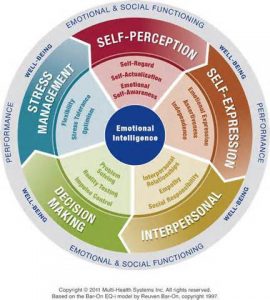 The world first took notice of Emotional Intelligence in the early 1990s. In the years since, this field of behavioral research has spun off a handful of conceptual models, many dozens of books on the subject, and a number of self-assessment and 360-feedback tools, the most popular of which is the EQ-i 2.0. The EQ-i identifies sixteen specifically defined elements that make up the behavioral face that we each bring and show to the world. What do we look and sound like—how do we act—within this meeting, in that conversation, when the details and circumstances of life come at us? Knowing how much—or how little—of a behavior we tend to “turn on” or deploy gives us a good idea of what we may each want or need to do more of or to ease back on. Being more intentional with our behavioral choices—and not just learning how to, but actually practicing getting better and more skilled with these behaviors—sharpening your EQ toolkit—that is the value of Emotional Intelligence assessments and training.
The world first took notice of Emotional Intelligence in the early 1990s. In the years since, this field of behavioral research has spun off a handful of conceptual models, many dozens of books on the subject, and a number of self-assessment and 360-feedback tools, the most popular of which is the EQ-i 2.0. The EQ-i identifies sixteen specifically defined elements that make up the behavioral face that we each bring and show to the world. What do we look and sound like—how do we act—within this meeting, in that conversation, when the details and circumstances of life come at us? Knowing how much—or how little—of a behavior we tend to “turn on” or deploy gives us a good idea of what we may each want or need to do more of or to ease back on. Being more intentional with our behavioral choices—and not just learning how to, but actually practicing getting better and more skilled with these behaviors—sharpening your EQ toolkit—that is the value of Emotional Intelligence assessments and training.
Here are some examples of what EQ development work often looks like.
Assertiveness & Independence
 Assertiveness is the ability and tendency to put your thoughts, opinions and needs out into the world—even when doing so will present some push-back or even conflict. Assertiveness is the exercise of your spine and voice in partnership—speaking up, taking a stand, putting a stake in the ground and defending it. Too little Assertiveness reflects or suggests weakness and/or a lack of substance.
Assertiveness is the ability and tendency to put your thoughts, opinions and needs out into the world—even when doing so will present some push-back or even conflict. Assertiveness is the exercise of your spine and voice in partnership—speaking up, taking a stand, putting a stake in the ground and defending it. Too little Assertiveness reflects or suggests weakness and/or a lack of substance.
 Independence is the ability and tendency to be autonomous and self-directed in your ideas, thoughts and feelings. Independence allows you to hold your own feelings or beliefs even in the face of disagreement. Independence allows you to zig even if the crowd around you is zagging. Too little Independence makes you (or makes you seem) dependent on those around you—too easily swayed, emotionally and intellectually, by the leader or the group.
Independence is the ability and tendency to be autonomous and self-directed in your ideas, thoughts and feelings. Independence allows you to hold your own feelings or beliefs even in the face of disagreement. Independence allows you to zig even if the crowd around you is zagging. Too little Independence makes you (or makes you seem) dependent on those around you—too easily swayed, emotionally and intellectually, by the leader or the group.
Independence is the internal knowing or belief; Assertiveness is giving that belief voice and action. As you might imagine, these two EQ elements often travel and work in tandem. Critical to success in leadership, organizational change, innovation and effectively giving feedback and engaging in difficult conversations, Independence and Assertiveness form the basis of competencies throughout so much of the leadership and managerial toolkit. A developmental focus within EQ work is often the access to and practice of using and bolstering your Independence and Assertiveness—finding and using your voice.
Interpersonal Relationships
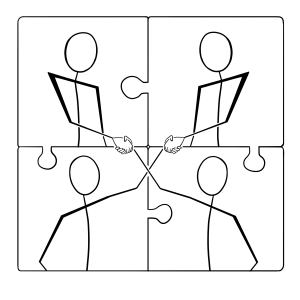 Within the EQ-i model, Interpersonal Relationships is the ability and tendency to establish and maintain relationships within which trust and compassion reside. Can you get people to like and trust you? Wanting to and working toward that end is the essence of Interpersonal Relationships. Not enough attention paid to Interpersonal Relationships results in your being or at least being seen as cold, unfriendly, untrustworthy, and hard to get to know and like. In teams, in negotiations, in leadership and in communication—people will listen to you, follow you, believe you only in so far as they trust you, and often times only if they like you. A frequently tapped effort within EQ-i work is the authentic adoption of interpersonal skills and practices—relationship management efforts.
Within the EQ-i model, Interpersonal Relationships is the ability and tendency to establish and maintain relationships within which trust and compassion reside. Can you get people to like and trust you? Wanting to and working toward that end is the essence of Interpersonal Relationships. Not enough attention paid to Interpersonal Relationships results in your being or at least being seen as cold, unfriendly, untrustworthy, and hard to get to know and like. In teams, in negotiations, in leadership and in communication—people will listen to you, follow you, believe you only in so far as they trust you, and often times only if they like you. A frequently tapped effort within EQ-i work is the authentic adoption of interpersonal skills and practices—relationship management efforts.
The Big 3
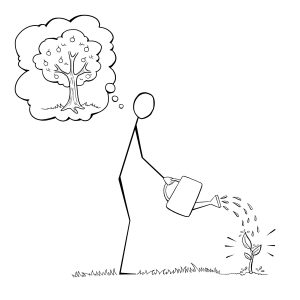 Optimism is the ability and tendency to see the future as a promising and positive place. Faith and hope both live in Optimism. Too little attention devoted to Optimism results in your looking and sounding pessimistic and negative—quick to give in and give up in the face of opposition or set-back.
Optimism is the ability and tendency to see the future as a promising and positive place. Faith and hope both live in Optimism. Too little attention devoted to Optimism results in your looking and sounding pessimistic and negative—quick to give in and give up in the face of opposition or set-back.
Self-Actualization is the ability and tendency to set a goal and strive towards its completion. More about the striving than the goal itself, Self-Actualization is your engine forward—your ability and tendency to deem something as important and to work with focus toward it. It is Self-Actualization that fuels any effort toward learning, development, and forward progress; therefore, too little Self-Actualization comes off looking and sounding lazy, bored, lacking ambition and complacent about learning, development, and progress in general.
 Self-Regard is your ability and tendency to see your full self—physical, intellectual, emotional—and in light of all these qualities regard yourself to be a good, likeable person. Self-esteem and confidence are rooted here, and without a healthy dose of Self-Regard, you project to the world uncertainty and self-doubt.
Self-Regard is your ability and tendency to see your full self—physical, intellectual, emotional—and in light of all these qualities regard yourself to be a good, likeable person. Self-esteem and confidence are rooted here, and without a healthy dose of Self-Regard, you project to the world uncertainty and self-doubt.
The Big 3—Within the EQ-i model of Emotional Intelligence, the power of Self-Regard, Self-Actualization and Optimism is hard to overstate. So much do they correlate with each other and so much does each one of them both need and feed the other two, that they are often referred to as the Big 3. A positive view of the future—Optimism—is needed to justify working toward future goals—Self-Actualization, and research shows us that setting goals and moving toward them is the single most powerful thing anyone can do to impact their Self-Regard. Research also shows us that nothing impacts and predicts your level of Optimism more than your Self-Regard, so these three elements strongly reinforce each other—upwardly or downwardly—either making us more effective and happy, or keeping us from being so.
Myriad leadership and organizational competencies are rooted in and fueled by EQ’s Big 3. Resilience, executive presence, confidence, leadership courage, ability to establish a vision and to inspire—so many of the skills we look to our leaders to exhibit have their building blocks right here in the Big 3. Competency assessments and feedback tools can point out deficiencies, but only EQ development can skill-build in these critical areas.
So What? Now What?
The reason for the tremendous popularity of Emotional Intelligence and the EQ-i is that this is both a system and a tool that allows people to assess their level of engagement with each of these 16 defined behaviors. The assessment allows for valid and focused quantification of these behaviors—what are you doing and how frequently, and what would benefit you to do more of? In the hands of a qualified and effective trainer or coach, the EQ-i can then unfold into and feed a development process to increase the frequency and skill with which these various behaviors are called up and used—not just measuring your performance, but actually sharpening your behavioral toolkit.
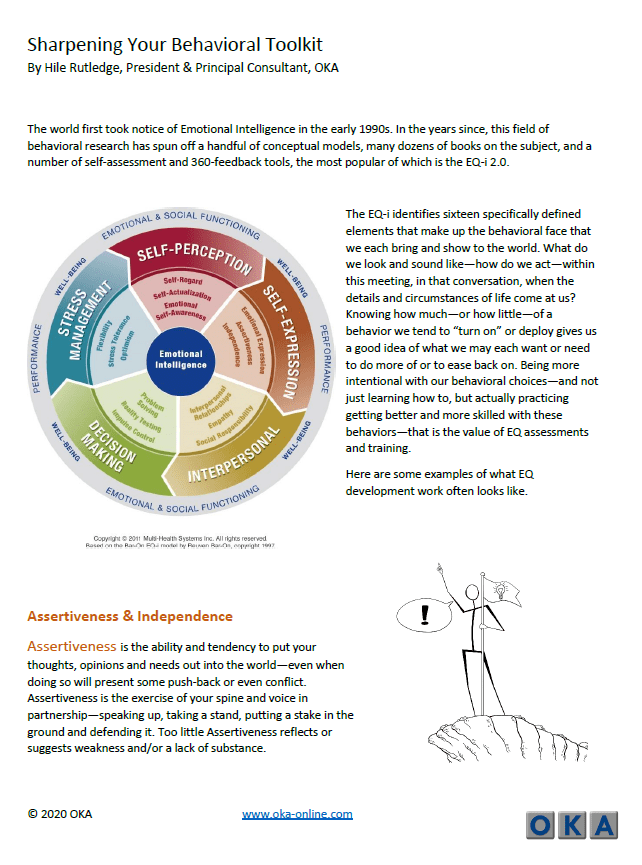 This article was written by request of the learning and development team within NATO–the North American Treaty Organization. Click this image to download a PDF of this article for your reference and use.
This article was written by request of the learning and development team within NATO–the North American Treaty Organization. Click this image to download a PDF of this article for your reference and use.


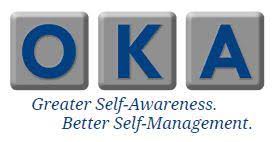
Leave a Comment